Natural Climate Protection through Peatland Rewetting: A Future for the Rathsbruch Peatland in Germany
Abstract
1. Introduction
2. Materials and Methods
2.1. Site Overview and Methodological Approach
- Catchment characteristics of the Rathsbruch peatland;
- Biodiversity, soil, and hydrological status;
- Engineering solution for peatland rewetting (short term, midterm);
- Administrative requirements for project impact assessment;
- Greenhouse gas binding potential of the rewetted Rathsbruch Peatland;
- Social aspects of the planning process;
- Environmental management in the long term.
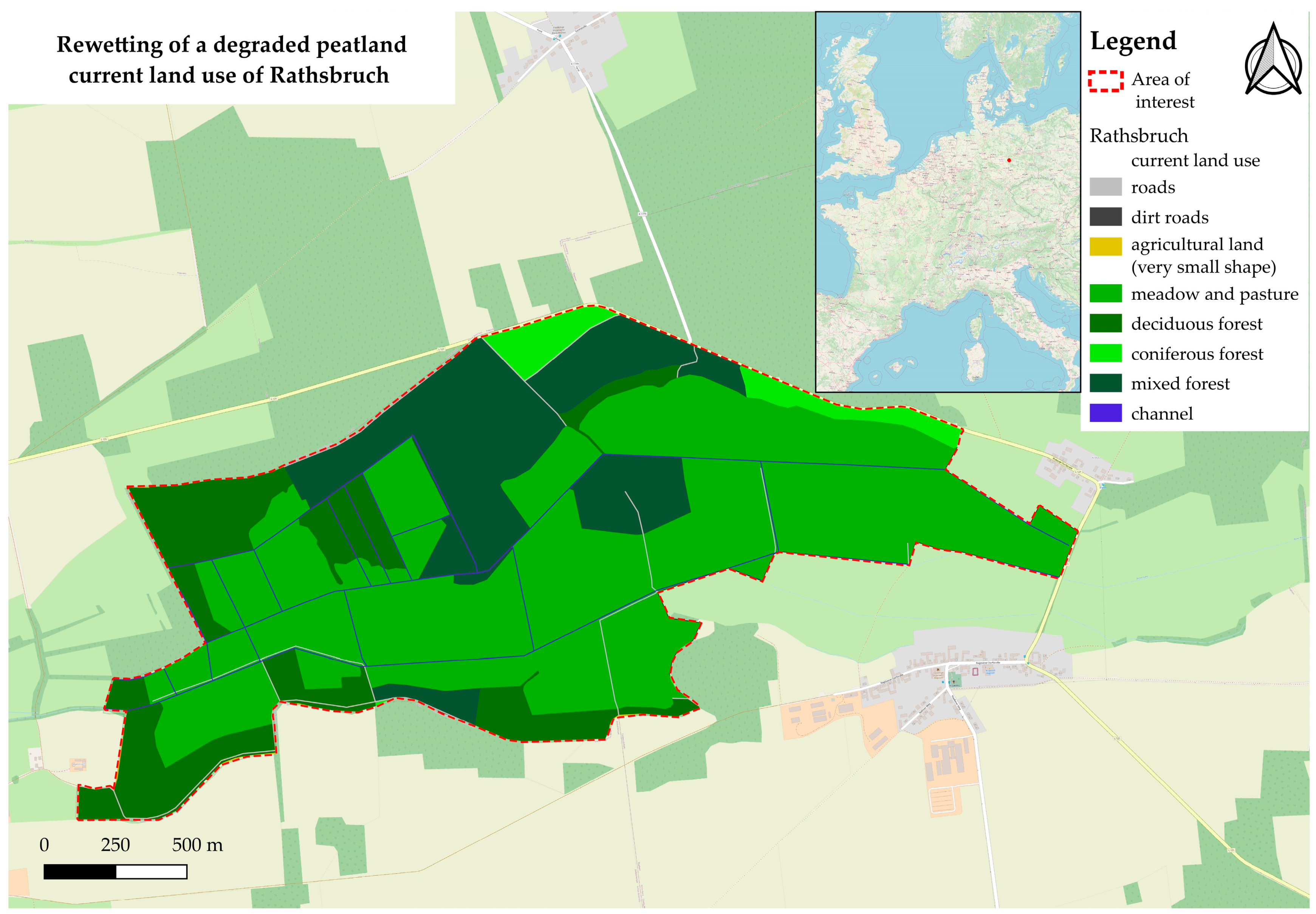
2.2. Site Characteristics: Hydrology, Soil and Land Use
2.3. Sampling of Macroinvertebrates and Fish
2.4. Assessment of the Ecological Status
2.5. Design Approach
2.6. Impact Assessment
2.6.1. Environmental Impact, Biodiversity, and Land Use Change
2.6.2. Estimating the Greenhouse Gas Emissions for Rewetting Szenario of Rathsbruch
3. Results
3.1. Catchment Characteristics of the Rathsbruch Peatland
- 0–20 cm below surface (BS): fine sand, medium sandy, slightly coarse sandy, slightly silty, organic components, decomposed, black-brown.
- 20–35 cm BS: fine sand, medium sandy, slightly coarse sandy, slightly silty, organic components, decomposed, black-brown.
- 35–42 cm BS: silt, clayey, strongly organic, black, final depth 42 cm BS.
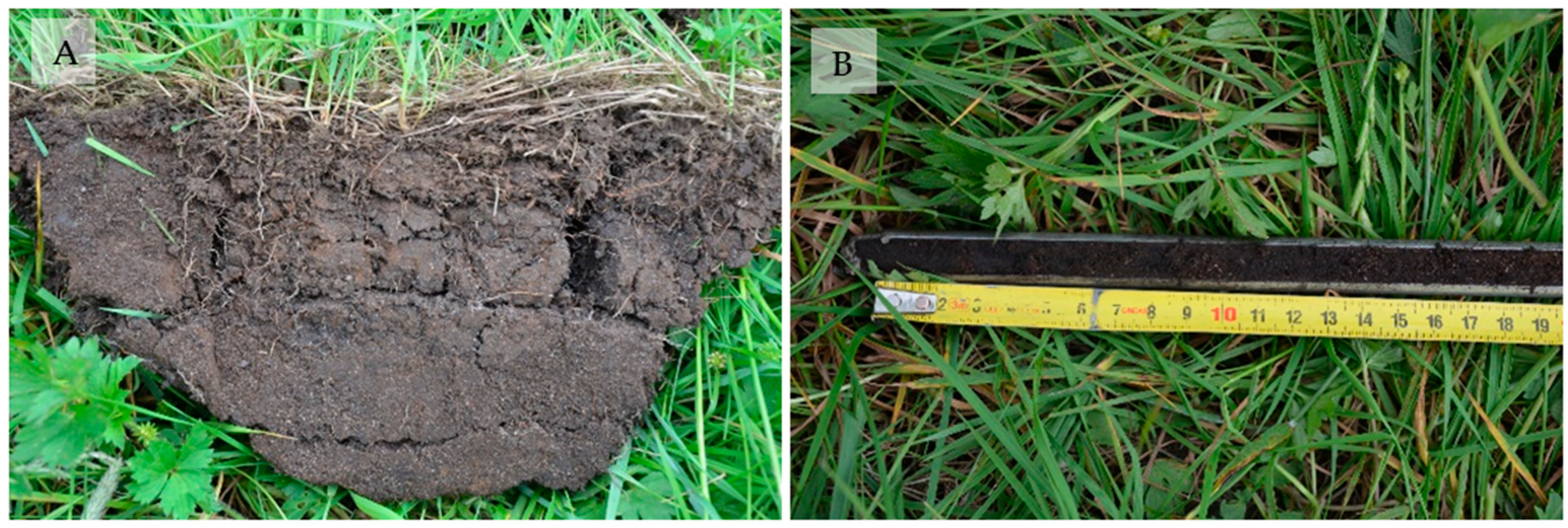
- 0–25 cm BS: fine sand, medium sandy, slightly silty, organic components, decomposed, black-brown.
- 25–65 cm BS: silt, clayey, strongly organic, black, final depth 65 cm BS.
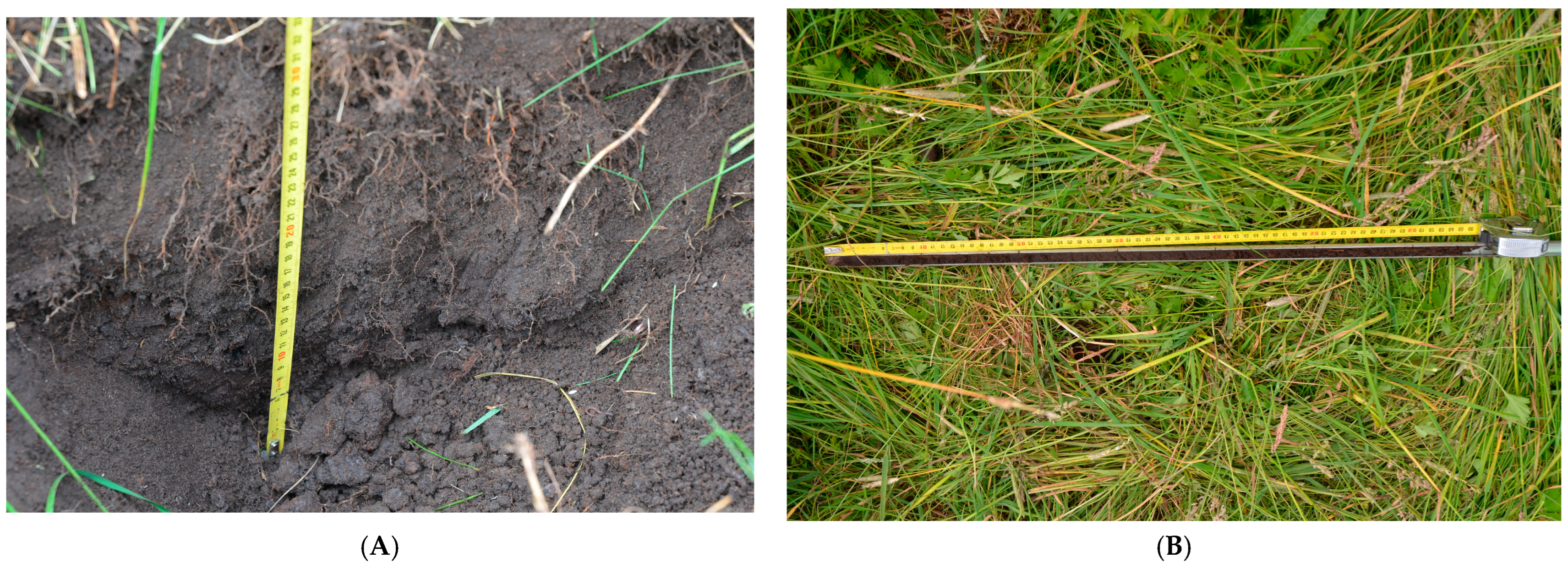
- 0–20 cm BS: fine sand, medium sandy, silty, organic components, decomposed, black-brown.
- 20–65 cm BS: silt, clayey, strongly organic, black.
- 65–66 cm BS: Coarse sand, fine sand, final depth 66 cm BS.
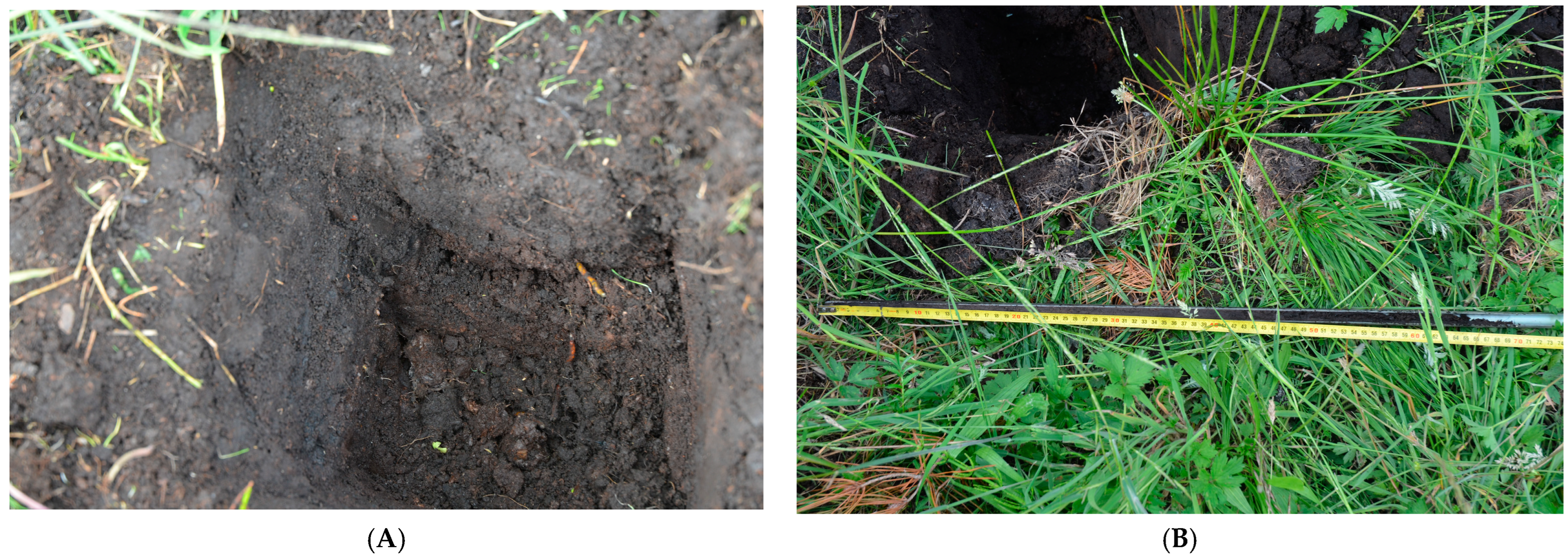
3.2. Ecosystems Assessment Results
3.2.1. Evaluation by means of Macroinvertebrate
3.2.2. Evaluation by Means of Fish
3.3. Restoration of the Boner Nuthe for Peatland Rewetting and Good Ecological Status of the Water Body: Rewetting Design Solution
3.4. Impact Assessment
3.4.1. Environmental Impact Assessment
3.4.2. Fauna–Flora–Habitats (FFH) Impact Assessment
3.4.3. Impact Assessment on Greenhouse Gas Emissions
4. Discussion
5. Conclusions
Author Contributions
Funding
Data Availability Statement
Acknowledgments
Conflicts of Interest
Appendix A
| Scenario 1 | Summed emissions | Carbon dioxide emissions | Methane emissions | ||||||
| Water level = −1 m | Mg CO2 eq. | Mg CO2 eq. | Mg CO2 eq. | ||||||
| year after rewetting | mean | min | max | mean | min | max | mean | min | max |
| 1 | 5313 | (2656–7969) | 5300 | (2650–7950) | 13 | (6–19) | |||
| 2 | 10,626 | (5313–15,939) | 10,600 | (5300–15,901) | 26 | (13–38) | |||
| 3 | 15,939 | (7969–23,908) | 15,901 | (7950–23,851) | 38 | (19–57) | |||
| 4 | 21,252 | (10,626–31,878) | 21,201 | (10,600–31,801) | 51 | (26–77) | |||
| 5 | 26,565 | (13,282–39,847) | 26,501 | (13,250–39,751) | 64 | (32–96) | |||
| Scenario 2 | Summed emissions | Carbon dioxide emissions | Methane emissions | ||||||
| Water level = −0.8 m | Mg CO2 eq. | Mg CO2 eq. | Mg CO2 eq. | ||||||
| year after rewetting | mean | min | max | mean | min | max | mean | min | max |
| 1 | 5312 | (2656–7969) | 5300 | (2650–7949) | 13 | (6–19) | |||
| 2 | 10,625 | (5312–15,937) | 10,599 | (5300–15,899) | 26 | (13–38) | |||
| 3 | 15,937 | (7969–23,906) | 15,899 | (7949–23,848) | 38 | (19–57) | |||
| 4 | 21,250 | (10,625–31,875) | 21,199 | (10,599–31,798) | 51 | (26–77) | |||
| 5 | 26,562 | (13,281–39,843) | 26,498 | (13,249–39,747) | 64 | (32–96) | |||
| Scenario 3 | Summed emissions | Carbon dioxide emissions | Methane emissions | ||||||
| Water level = –0.5 m | Mg CO2 eq. | Mg CO2 eq. | Mg CO2 eq. | ||||||
| year after rewetting | mean | min | max | mean | min | max | mean | min | max |
| 1 | 5285 | (2643–7928) | 5273 | (2636–7909) | 13 | (6–19) | |||
| 2 | 10,571 | (5285–15,856) | 10,545 | (5273–15,818) | 26 | (13–38) | |||
| 3 | 15,856 | (7928–23,784) | 15,818 | (7909–23,727) | 38 | (19–57) | |||
| 4 | 21,142 | (10,571–31,713) | 21,091 | (10,545–31,636) | 51 | (26–77) | |||
| 5 | 26,427 | (13,214–39,641) | 26,363 | (13,182–39,545) | 64 | (32–96) | |||
| Scenario 4 | Summed emissions | Carbon dioxide emissions | Methane emissions | ||||||
| Water level = −0.3 m | Mg CO2 eq. | Mg CO2 eq. | Mg CO2 eq. | ||||||
| year after rewetting | mean | min | max | mean | min | max | mean | min | max |
| 1 | 4969 | (2485–7454) | 4956 | (2478–7435) | 13 | (6–19) | |||
| 2 | 9938 | (4969–14,908) | 9913 | (4956–14,869) | 26 | (13–39) | |||
| 3 | 14,908 | (7454–22,362) | 14,869 | (7435–22,304) | 39 | (19–58) | |||
| 4 | 19,877 | (9938–29,815) | 19,826 | (9913–29,738) | 51 | (26–77) | |||
| 5 | 24,846 | (12,423–37,269) | 24,782 | (12,391–37,173) | 64 | (32–96) | |||
| Scenario 5 | Summed emissions | Carbon dioxide emissions | Methane emissions | ||||||
| Water level = −0.1 m | Mg CO2 eq. | Mg CO2 eq. | Mg CO2 eq. | ||||||
| year after rewetting | mean | min | max | mean | min | max | mean | min | max |
| 1 | 3620 | (1810–5429) | 3194 | (1597–4792) | 425 | (213–638) | |||
| 2 | 7239 | (3620–10,859) | 6389 | (3194–9583) | 850 | (425–1275) | |||
| 3 | 10,859 | (5429–16,288) | 9583 | (4792–14,375) | 1275 | (638–1913) | |||
| 4 | 14,478 | (7239–21,718) | 12,778 | (6389–19,167) | 1701 | (850–2551) | |||
| 5 | 18,098 | (9049–27,147) | 15,972 | (7986–23,958) | 2126 | (1063–3189) | |||
| Scenario 1 | Emissions | Environmental damage costs (time preference: 2%) | ||||
| Water level = –1 m | Mg CO2 eq. | EUR | ||||
| year after rewetting/price in EUR per Mg CO2 | mean | min | max | mean | min | max |
| 1/699.72 | 5313 | (2656−7969) | 3,790,469 | (1,895,234−5685,703) | ||
| 2/713.44 | 10,626 | (5313−15,939) | 7,726,724 | (3,863,362−11,590,086) | ||
| 3/727.16 | 15,939 | (7969−23,908) | 11,808,767 | (5,904,384−17,713,151) | ||
| 4/740.88 | 21,252 | (10,626−31,878) | 16,036,598 | (8,018,299−24,054,896) | ||
| 5/754.60 | 26,565 | (13,282−39,847) | 20,410,215 | (10,205,108−30,615,323) | ||
| Scenario 2 | Emissions | Environmental damage costs (time preference: 2%) | ||||
| Water level = –0.8 m | Mg CO2 eq. | EUR | ||||
| year after rewetting/price in EUR per Mg CO2 | mean | min | max | mean | min | max |
| 1/699.72 | 5312 | (2656−7969) | 3,790,102 | (1,895,051−5685,153) | ||
| 2/713.44 | 10,625 | (5312−15,937) | 7,725,977 | (3,862,989−11,588,966) | ||
| 3/727.16 | 15,937 | (7969−23,906) | 11,807,625 | (5,903,812−17,711,437) | ||
| 4/740.88 | 21,250 | (10,625−31,875) | 16,035,046 | (8,017,523−24,052,568) | ||
| 5/754.60 | 26,562 | (13,281−39,843) | 20,408,239 | (10,204,120−30,612,359) | ||
| Scenario 3 | Emissions | Environmental damage costs (time preference: 2%) | ||||
| Water level = –0.5 m | Mg CO2 eq. | EUR | ||||
| year after rewetting/price in EUR per Mg CO2 | mean | min | max | mean | min | max |
| 1/699.72 | 5285 | (2643−7928) | 3,771,216 | (1,885,608−5,656,824) | ||
| 2/713.44 | 10,571 | (5285−15,856) | 7,687,464 | (3,843,732−11,531,196) | ||
| 3/727.16 | 15,856 | (7928−23,784) | 11,748,745 | (5,874,372−17,623,117) | ||
| 4/740.88 | 21,142 | (10,571−31,713) | 15,955,058 | (7,977,529−23,932,586) | ||
| 5/754.60 | 26,427 | (13,214−39,641) | 20,306,403 | (10,153,201−30,459,604) | ||
| Scenario 4 | Emissions | Environmental damage costs (time preference: 2%) | ||||
| Water level = –0.3 m | Mg CO2 eq. | EUR | ||||
| year after rewetting/price in EUR per Mg CO2 | mean | min | max | mean | min | max |
| 1/699.72 | 4969 | (2485−7454) | 3,549,969 | (1,774,984−5,324,953) | ||
| 2/713.44 | 9938 | (4969−14,908) | 7,236,293 | (3,618,147−10,854,440) | ||
| 3/727.16 | 14,908 | (7454−22,362) | 11,058,974 | (5,529,487−16,588,461) | ||
| 4/740.88 | 19,877 | (9938−29,815) | 15,018,010 | (7,509,005−22,527,015) | ||
| 5/754.60 | 24,846 | (12,423−37,269) | 19,113,402 | (9,556,701−28,670,103) | ||
| Scenario 5 | Emissions | Environmental damage costs (time preference: 2%) | ||||
| Water level = –0.1 m | Mg CO2 eq. | EUR | ||||
| year after rewetting/price in EUR per Mg CO2 | mean | min | max | mean | min | max |
| 1/699.72 | 3620 | (1810−5429) | 2,605,594 | (1,302,797−3,908,391) | ||
| 2/713.44 | 7239 | (3620−10,859) | 5,310,509 | (2,655,254−7,965,763) | ||
| 3/727.16 | 10,859 | (5429−16,288) | 8,114,746 | (4,057,373−12,172,119) | ||
| 4/740.88 | 14,478 | (7239−21,718) | 11,018,304 | (5,509,152−16,527,456) | ||
| 5/754.60 | 18,098 | (9049−27,147) | 14,021,184 | (7,010,592−21,031,776) | ||
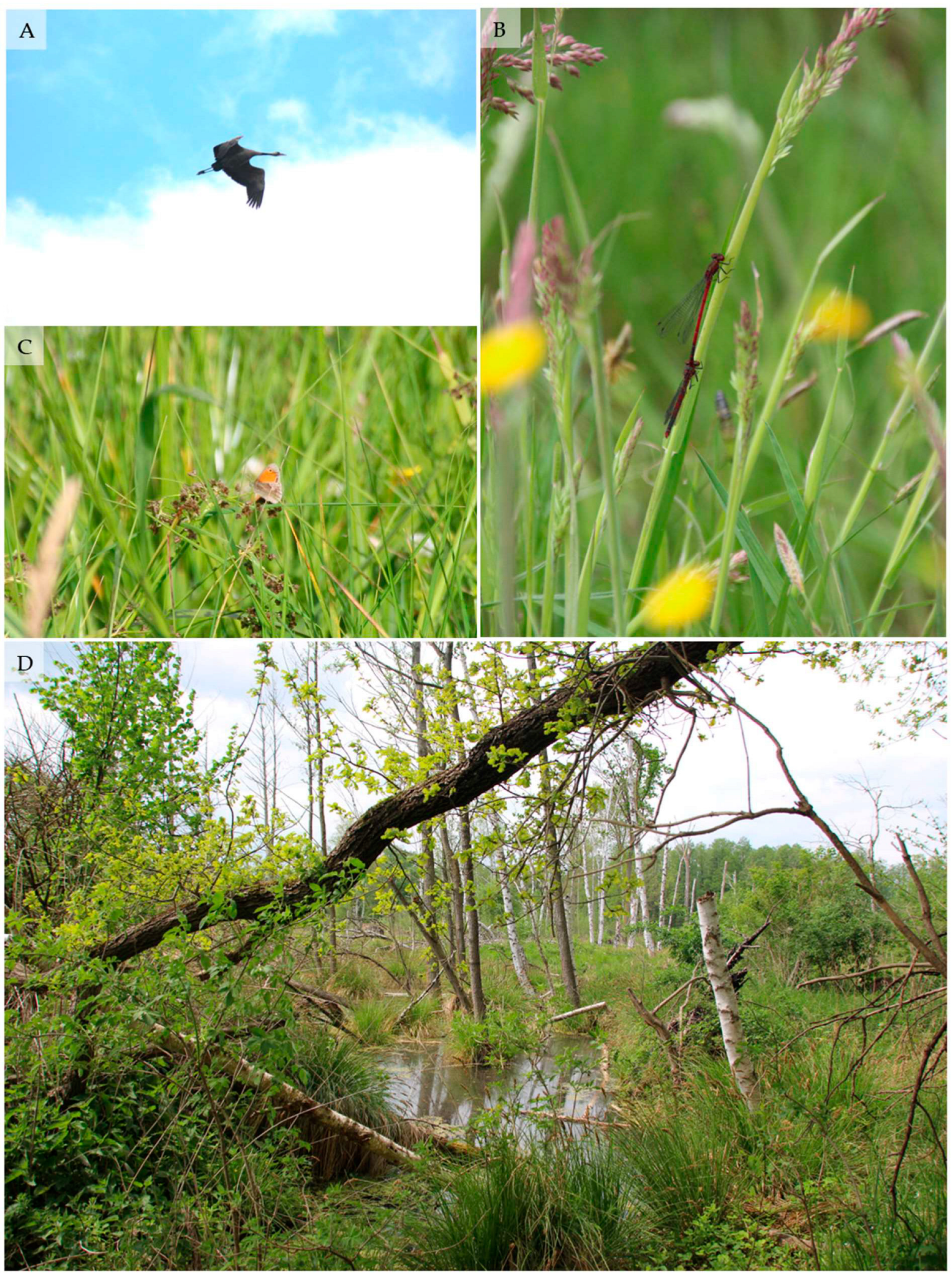
References
- Jewell, J.; Cherp, A. On the political feasibility of climate change mitigation pathways: Is it too late to keep warming below 1.5 °C? WIREs Clim. Chang. 2019, 11, e621. [Google Scholar] [CrossRef]
- Shin, Y.-J.; Arneth, A.; Chowdhury, R.; Midgley, G.F.; Bukvareva, E.; Heinimann, A.; Horcea-Milcu, A.I.; Kolb, M.; Leadley, P.; Oberdorff, T.; et al. Plausible futures of nature, its contributions to people and their good quality of life. In The Global Assessment Report on Biodiversity and Ecosystem Services; Brondízio, E.S., Settele, J., Diaz, S., Ngo, H.T., Eds.; IPBES: Bonn, Germany, 2019; pp. 600–766. [Google Scholar]
- Schneider, P.; Fauk, T.; Mihai, F.C. Reclaiming Urban Brownfields and Industrial Areas–Potentials for Agroecology. In Agroecological Approaches for Sustainable Soil Management; Prasad, M.N.V., Kumar, C., Eds.; Wiley: Hoboken, NJ, USA, 2023; pp. 409–436. [Google Scholar]
- Mihai, F.C.; Schneider, P.; Eva, M. Ecological engineering and green infrastructure in mitigating emerging urban environmental threats. In Handbook of Ecological and Ecosystem Engineering; Prasad, M.N.V., Ed.; Wiley: Hoboken, NJ, USA, 2021; pp. 95–121. [Google Scholar] [CrossRef]
- Temmink, R.J.; Robroek, B.J.; van Dijk, G.; Koks, A.H.; Käärmelahti, S.A.; Barthelmes, A.; Wassen, M.J.; Ziegler, R.; Steele, M.N.; Giesen, W.; et al. Wetscapes: Restoring and maintaining peatland landscapes for sustainable futures. Ambio 2023, 52, 1519–1528. [Google Scholar] [CrossRef]
- Zou, J.; Ziegler, A.D.; Chen, D.; McNicol, G.; Ciais, P.; Jiang, X.; Zheng, C.; Wu, J.; Wu, J.; Lin, Z.; et al. Rewetting global wetlands effectively reduces major greenhouse gas emissions. Nat. Geosci. 2022, 15, 627–632. [Google Scholar] [CrossRef]
- Koch, J.; Elsgaard, L.; Greve, M.H.; Gyldenkærne, S.; Hermansen, C.; Levin, G.; Wu, S.; Stisen, S. Water-table-driven greenhouse gas emission estimates guide peatland restoration at national scale. Biogeosciences 2023, 20, 2387–2403. [Google Scholar] [CrossRef]
- Zak, D.; McInnes, R.J. A call for refining the peatland restoration strategy in Europe. J. Appl. Ecol. 2022, 59, 2698–2704. [Google Scholar] [CrossRef]
- Minasny, B.; Adetsu, D.V.; Aitkenhead, M.; Artz, R.R.; Baggaley, N.; Barthelmes, A.; Beucher, A.; Caron, J.; Conchedda, G.; Connolly, J.; et al. Mapping and monitoring peatland conditions from global to field scale. Biogeochemistry 2023. [Google Scholar] [CrossRef]
- Wetlands International 2022. Peatlands in the EU Nature Restoration Law—A Factsheet. Available online: https://europe.wetlands.org/news/peatlands-in-the-eu-nature-restoration-law-a-factsheet/ (accessed on 14 July 2022).
- Bundesministerium für Umwelt, Naturschutz, nukleare Sicherheit und Verbraucherschutz. Nationale Moorschutzstrategie. 2022. Available online: https://www.bmuv.de/download/nationale-moorschutzstrategie (accessed on 8 September 2023).
- Brunotte, E.; Gebhardt, H.; Meurer, M.; Meusburger, P.; Nipper, J. Lexikon der Geographie; Spektrum: Heidelberg, Germany, 2002; ISBN 3-8274-0416-9. [Google Scholar]
- Ahmad, S.; Liu, H.; Alam, S.; Günther, A.; Jurasinski, G.; Lennartz, B. Meteorological Controls on Water Table Dynamics in Fen Peatlands Depend on Management Regimes. Front. Earth Sci. 2021, 9, 630469. [Google Scholar] [CrossRef]
- Chen, C.; Loft, L.; Matzdorf, B. Lost in action: Climate friendly use of European peatlands needs coherence and incentive-based policies. Environ. Sci. Policy 2023, 145, 104–115. [Google Scholar] [CrossRef]
- Byg, A.; Novo, P.; Kyle, C. Caring for Cinderella—Perceptions and experiences of peatland restoration in Scotland. People Nat. 2020, 5, 302–312. [Google Scholar] [CrossRef]
- Martino, S.; Kenter, J.O.; Albers, N.; Whittingham, M.J.; Young, D.M.; Pearce-Higgins, J.W.; Martin-Ortega, J.; Glenk, K.; Reed, M.S. Trade-offs between the natural environment and recreational infrastructure: A case study about peatlands under different management scenarios. Land Use Policy 2022, 123, 106401. [Google Scholar] [CrossRef]
- Chen, C.; Loft, L.; Sattler, C.; Matzdorf, B. Developing regional voluntary carbon markets for peatlands: Innovation processes and influencing factors. Clim. Policy 2022, 23, 238–253. [Google Scholar] [CrossRef]
- Banerjee, A.; Schuitema, G. Spatial justice as a prerequisite for a just transition in rural areas? The case study from the Irish peatlands. Environ. Plan. C Politi. Space 2023, 41, 1096–1112. [Google Scholar] [CrossRef]
- Zerbe, S. Actors and Stakeholders and Their Role in Ecosystem Restoration: Conflict Resolution and Acceptance Through Participation. In Restoration of Ecosystems–Bridging Nature and Humans: A Transdisciplinary Approach; Springer: Berlin/Heidelberg, Germany, 2023; pp. 473–486. [Google Scholar]
- Räsänen, A.; Albrecht, E.; Annala, M.; Aro, L.; Laine, A.M.; Maanavilja, L.; Mustajoki, J.; Ronkanen, A.-K.; Silvan, N.; Tarvainen, O.; et al. After-use of peat extraction sites–A systematic review of biodiversity, climate, hydrological and social impacts. Sci. Total Environ. 2023, 882, 163583. [Google Scholar] [CrossRef] [PubMed]
- Lin, F.; Zuo, H.; Ma, X.; Ma, L. Comprehensive assessment of nitrous oxide emissions and mitigation potentials across European peatlands. Environ. Pollut. 2022, 301, 119041. [Google Scholar] [CrossRef] [PubMed]
- Günther, A.; Barthelmes, A.; Huth, V.; Joosten, H.; Jurasinski, G.; Koebsch, F.; Couwenberg, J. Prompt rewetting of drained peatlands reduces climate warming despite methane emissions. Nat. Commun. 2020, 11, 1644. [Google Scholar] [CrossRef] [PubMed]
- Schwieger, S.; Kreyling, J.; Peters, B.; Gillert, A.; von Lukas, U.F.; Jurasinski, G.; Köhn, D.; Blume-Werry, G. Rewetting prolongs root growing season in minerotrophic peatlands and mitigates negative drought effects. J. Appl. Ecol. 2022, 59, 2106–2116. [Google Scholar] [CrossRef]
- Makrickas, E.; Manton, M.; Angelstam, P.; Grygoruk, M. Trading wood for water and carbon in peatland forests? Rewetting is worth more than wood production. J. Environ. Manag. 2023, 341, 117952. [Google Scholar] [CrossRef] [PubMed]
- Dahm, J. German Stakeholders Divided Over EU’s New Peatland Targets. 2022. Available online: https://www.euractiv.com/section/agriculture-food/news/german-stakeholders-divided-over-eus-new-peatland-targets/ (accessed on 8 September 2023).
- Schaller, C.; Hofer, B.; Klemm, O. Greenhouse Gas Exchange of a NW German Peatland, 18 Years After Rewetting. J. Geophys. Res. Biogeosciences 2022, 127, e2020JG005960. [Google Scholar] [CrossRef]
- Tanneberger, F.; Schröder, C.; Hohlbein, M.; Lenschow, U.; Permien, T.; Wichmann, S.; Wichtmann, W. Climate Change Mitigation through Land Use on Rewetted Peatlands—Cross-Sectoral Spatial Planning for Paludiculture in Northeast Germany. Wetlands 2020, 40, 2309–2320. [Google Scholar] [CrossRef]
- Tanneberger, F.; Moen, A.; Barthelmes, A.; Lewis, E.; Miles, L.; Sirin, A.; Tegetmeyer, C.; Joosten, H. Mires in Europe—Regional Diversity, Condition and Protection. Diversity 2021, 13, 381. [Google Scholar] [CrossRef]
- Saxony-Anhalt State Office for Surveying and Geoinformation (LVermGeo)—Digital Terrain Model. Available online: https://www.lvermgeo.sachsen-anhalt.de/de/gdp-open-data.html (accessed on 20 January 2024).
- Billetoft, B.; Winter-Huneck, B.; Peterson, J.; Schmidt, W. 9160 Subatlantischer oder mitteleuropäischer Stieleichenwald oder Eichen-Hainbuchenwald (Carpinion betuli). In Naturschutz im Land Sachsen-Anhalt; Landesamt für Umweltschutz, Ed.; 2002; Publisher: Federal State Sachsen-Anhalt, Authority for Environmental Protection; Available online: https://lau.sachsen-anhalt.de/fileadmin/Bibliothek/Politik_und_Verwaltung/MLU/LAU/Naturschutz/Arten-_und_Biotopschutz/Lebensraumtypen/Dateien/LRT_9160.pdf (accessed on 20 January 2024).
- LPR Landschaftsplanung Dr. Reichhoff GmbH. Managementplan für das FFH-Gebiet. Obere Nuthe-Läufe, 2022; unpublished. [Google Scholar]
- Billetoft, B.; Winter-Huneck, B.; Peterson, J.; Schmidt, W. 91E0* Auenwälder mit Alnus glutinosa und Fraxinus excelsior (Alno padion, Alnion incanae, Salicion albae). In Naturschutz im Land Sachsen-Anhalt; Landesamt für Umweltschutz, Ed.; 2002; Publisher: Federal State Sachsen-Anhalt, Authority for Environmental Protection; Available online: https://lau.sachsen-anhalt.de/fileadmin/Bibliothek/Politik_und_Verwaltung/MLU/LAU/Naturschutz/Arten-_und_Biotopschutz/Lebensraumtypen/Dateien/LRT_91E0-1.pdf (accessed on 20 January 2024).
- Jäger, U.; Peterson, J.; Blank, C. 6510 Magere Flachland-Mähwiesen (Alopecurus pratensis, Sanguisorba officinalis). In Naturschutz im Land Sachsen-Anhalt; Landesamt für Umweltschutz, Ed.; 2002; Publisher: Federal State Sachsen-Anhalt, Authority for Environmental Protection; Available online: https://lau.sachsen-anhalt.de/fileadmin/Bibliothek/Politik_und_Verwaltung/MLU/LAU/Naturschutz/Arten-_und_Biotopschutz/Lebensraumtypen/Dateien/LRT_6510.pdf (accessed on 20 January 2024).
- Saxony-Anhalt State Office for Geology and Mining (LAGB)—Soil Maps. Available online: https://www.geodatenportal.sachsen-anhalt.de/mapapps/resources/apps/viewer_v40/index.html?lang=de (accessed on 20 January 2024).
- Lüderitz, V.; Speierl, T.; Langheinrich, U.; Völkl, W.; Gersberg, R.M. Restoration of the Upper Main and Rodach rivers—The success and its measurement. Ecol. Eng. 2011, 37, 2044–2055. [Google Scholar] [CrossRef]
- Seidel, M.; Li, F.; Langheinrich, U.; Gersberg, R.M.; Lüderitz, V. Self-dynamics as a driver for restoration success in a lowland stream reach. Limnologica 2021, 88, 125873. [Google Scholar] [CrossRef]
- Dußling, U. Handbuch zu fiBS, Hilfestellung und Hinweise zur sachgerechten Anwendung des fischbasierten Bewertungsverfahrens (Manual on fiBS. Assistance and advice on the proper use of the fish-based assessment procedure fiBS (in German), Version 8.0.6. Schriftenreihe des Verbandes Deutscher Fischereiverwaltungsbeamter und Fischereiwissenschaftler (VDFF) e.V. Verbandes Deutscher Fischereiverwaltungsbeamter und Fischereiwissenschaftler (VDFF): Rostock, Germany, 2009; Heft 15.
- National Ministry for Environment, Nature Protection, Nuclear Safety and Consumer Protection. National Strategy on Biological Diversity 2030—First draft, Nationale Strategie zur Biologischen Vielfalt 2030—Diskussionsvorschläge des BMUV. 2022. Available online: https://www.bmuv.de/themen/naturschutz/allgemeines-/-strategien/nationale-strategie (accessed on 12 October 2023).
- Jia, G.; Shevliakova, E.; Artaxo, P.; De Noblet-Ducoudré, N.; Houghton, R.; House, J.; Kitajima, K.; Lennard, C.; Popp, A.; Sirin, A.; et al. Land-climate interactions. In Climate Change and Land: An IPCC Special Report on Climate Change, Desertification, Land Degradation, Sustainable Land Management, Food Security, and Greenhouse Gas Fluxes in Terrestrial Ecosystems; Schukla, P.R., Skea, J., Calvo Buendia, E., Masson-Delmotte, V., Partner, H.-O., Roberts, D.C., Zhai, P., Slade, R., Connors, S., van Diemen, R., et al., Eds.; Report of the Intergovernmental Panel on Climate Change; Intergovernmental Panel on Climate Change: Geneva, Switzerland, 2019. [Google Scholar] [CrossRef]
- Olsson, L.; Barbosa, H.; Bhadwal, S.; Cowie, A.; Delusca, K.; Flores-Renteria, D.; Hermans, K.; Jobbagy, E.; Kurz, W.; Li, D.; et al. Land degradation. In Climate Change and Land: An IPCC Special Report on Climate Change, Desertification, Land Degradation, Sustainable Land Management, Food Security, and Greenhouse Gas Fluxes in Terrestrial Ecosystems; Schukla, P.R., Skea, J., Calvo Buendia, E., Masson-Delmotte, V., Partner, H.-O., Roberts, D.C., Zhai, P., Slade, R., Connors, S., van Diemen, R., et al., Eds.; Report of the Intergovernmental Panel on Climate Change; Intergovernmental Panel on Climate Change: Geneva, Switzerland, 2019. [Google Scholar] [CrossRef]
- Tiemeyer, B.; Freibauer, A.; Borraz, E.A.; Augustin, J.; Bechtold, M.; Beetz, S.; Beyer, C.; Ebli, M.; Eickenscheidt, T.; Fiedler, S.; et al. A new methodology for organic soils in national greenhouse gas inventories: Data synthesis, derivation and application. Ecol. Indic. 2020, 109, 105838. [Google Scholar] [CrossRef]
- openLCA 1.9.0. Copyright (c) 2007–2019 GreenDelta. openLCA with Ecoinvent Database. Software. Available online: http://openlca.org (accessed on 20 November 2023).
- McConkey, B.G.; Ogle, S.; Chirinda, N.; Kishimoto, A.W.M.; Baldock, J.; Trunov, A.; Alsaker, C.; Lehmann, J.; Woolf, D. Chapter 6—Grassland. In 2019 Refinement to the 2006 IPCC Guidelines for National Greenhouse Gas Inventories—Volume 4 Agriculture, Forestry, and other Land Use; Calvo Buendia, E., Tanabe, K., Kranjc, A., Baasansuren, J., Fukuda, M., Ngarize, S., Osaka, A., Py-rozhenko, Y., Shermanau, P., Federici, S., Eds.; Report of the Intergovernmental Panel on Climate Change; Intergovernmental Panel on Climate Change: Geneva, Switzerland, 2019; ISBN 978-4-88788-232-4. [Google Scholar]
- Fauk, T.; Schneider, P. Modeling urban tree growth as a part of the green infrastructure to estimate ecosystem services in urban planning. Front. Environ. Sci. 2023, 11, 1090652. [Google Scholar] [CrossRef]
- Gensior, A.; Fuß, R.; Laggner, A.; Döring, U. Grünland. In Berichterstattung unter der Klimarahmenkonvention der Vereinten Nationen und dem Kyoto-Protokoll—Nationaler Inventarbericht zum Deutschen Treibhausgasinventar 1990–2020; Günther, D., Gniffke, P., Eds.; Umweltbundesamt: Dessau-Roßlau, Germany, 2022; ISSN 1862-4359. [Google Scholar]
- Zerbe, S. Chapter 8—Moore. In Renaturierung von Ökosystemen im Spannungsfeld von Mensch und Umwelt; Springer Nature: Berlin/Heidelberg, Germany, 2019; pp. 151–183. [Google Scholar] [CrossRef]
- Matthey, A.; Bünger, B. Methodenkonvention 3.1 zur Ermittlung von Umweltkosten—Kostensätze; Umweltbundesamt: Dessau-Roßlau, Germany, 2020. ISSN 1862-4804. Available online: https://www.umweltbundesamt.de/sites/default/files/medien/1410/publikationen/2020-12-21_methodenkonvention_3_1_kostensaetze.pdf (accessed on 20 November 2023).
- Bünger, B.; Matthey, A. Methodenkonvention 3.0 zur Ermittlung von Umweltkosten—Methodische Grundlagen; Umweltbundesamt: Dessau-Roßlau, Germany, 2018. Available online: https://www.umweltbundesamt.de/sites/default/files/medien/1410/publikationen/2018-11-12_methodenkonvention-3-0_methodische-grundlagen.pdf (accessed on 20th November 2023).
- Wittig, R.; Niekisch, M. Chapter 7—The habitats in Central Europe (Die Lebensräume in Mitteleuropa). In Biodiversität: Grundlagen, Gefährdung, Schutz; Springer Nature: Berlin/Heidelberg, Germany, 2014; pp. 149–191. Available online: https://link.springer.com/book/10.1007/978-3-642-54694-5 (accessed on 20 November 2023).
- Bartsch, N.; Röhrig, E. Chapter 5—Forest-like plant formations (Waldähnliche Pflanzenformationen). In Waldökologie; Springer Nature: Berlin/Heidelberg, Germany, 2016; pp. 43–53. Available online: https://link.springer.com/book/10.1007/978-3-662-44268-5 (accessed on 20 November 2023).
- Xu, S.; Wang, M.; Zhou, J.; Huang, Y.; Zhang, J.; Wang, S. Soil bacteria, archaea, and enzymatic activity of natural and rewetted peatlands display varying patterns in response to water levels. Catena 2023, 228, 107191. [Google Scholar] [CrossRef]
- Zhou, Y.; Sachs, T.; Li, Z.; Pang, Y.; Xu, J.; Kalhori, A.; Wille, C.; Peng, X.; Fu, X.; Wu, Y.; et al. Long-term effects of rewetting and drought on GPP in a temperate peatland based on satellite remote sensing data. Sci. Total Environ. 2023, 882, 163395. [Google Scholar] [CrossRef] [PubMed]
- Ball, J.; Gimona, A.; Cowie, N.; Hancock, M.; Klein, D.; Donaldson-Selby, G.; Artz, R.R. Assessing the Potential of using Sentinel-1 and 2 or high-resolution aerial imagery data with Machine Learning and Data Science Techniques to Model Peatland Restoration Progress—A Northern Scotland case study. Int. J. Remote Sens. 2023, 44, 2885–2911. [Google Scholar] [CrossRef]
- Stammel, B.; Fischer, C.; Cyffka, B.; Albert, C.; Damm, C.; Dehnhardt, A.; Fischer, H.; Foeckler, F.; Gerstner, L.; Hoffmann, T.G.; et al. Assessing land use and flood management impacts on ecosystem services in a river landscape (Upper Danube, Germany). River Res. Appl. 2020, 37, 209–220. [Google Scholar] [CrossRef]
- Doelman, J.C.; Verhagen, W.; Stehfest, E.; van Vuuren, D.P. The role of peatland degradation, protection and restoration for climate change mitigation in the SSP scenarios. Environ. Res. Clim. 2023, 2, 035002. [Google Scholar] [CrossRef]
- Beadle, J.M.; Holden, J.; Brown, L.E. Landscape-scale peatland rewetting benefits aquatic invertebrate communities. Biol. Conserv. 2023, 283, 110116. [Google Scholar] [CrossRef]
- Robinson, C.H.; Ritson, J.P.; Alderson, D.M.; Malik, A.A.; Griffiths, R.I.; Heinemeyer, A.; Gallego-Sala, A.V.; Quillet, A.; Robroek, B.J.M.; Evans, C.; et al. Aspects of microbial communities in peatland carbon cycling under changing climate and land use pressures. Mires Peat 2023, 29, 2. [Google Scholar] [CrossRef]
- Howson, T.; Evans, M.; Allott, T.; Shuttleworth, E.; Johnston, A.; Rees, J.; Milledge, D.; Edokpa, D.; Lockyer, C.; Kay, M.; et al. Peatland gully restoration with stone and timber dams (Kinder Plateau, UK). Ecol. Eng. 2023, 195, 107066. [Google Scholar] [CrossRef]
- Fatimah, Y.A.; Prasojo, Z.H.; Smith, S.W.; Rahman, N.E.B.; Wardle, D.A.; Chong, K.Y.; Saad, A.; Lee, J.S. Multi-level actor-network: Case of Peatland programs in a Riau Village, Indonesia (1974–2020). Geoforum 2023, 145, 103829. [Google Scholar] [CrossRef]
- Temmink, R.J.M.; Vroom, R.J.E.; van Dijk, G.; Käärmelahti, S.A.; Koks, A.H.W.; Joosten, H.; Krebs, M.; Gaudig, G.; Brust, K.; Lamers, L.P.M.; et al. Restoring organic matter, carbon and nutrient accumulation in degraded peatlands: 10 years Sphagnum paludiculture. Biogeochemistry 2023, 1–15. [Google Scholar] [CrossRef]
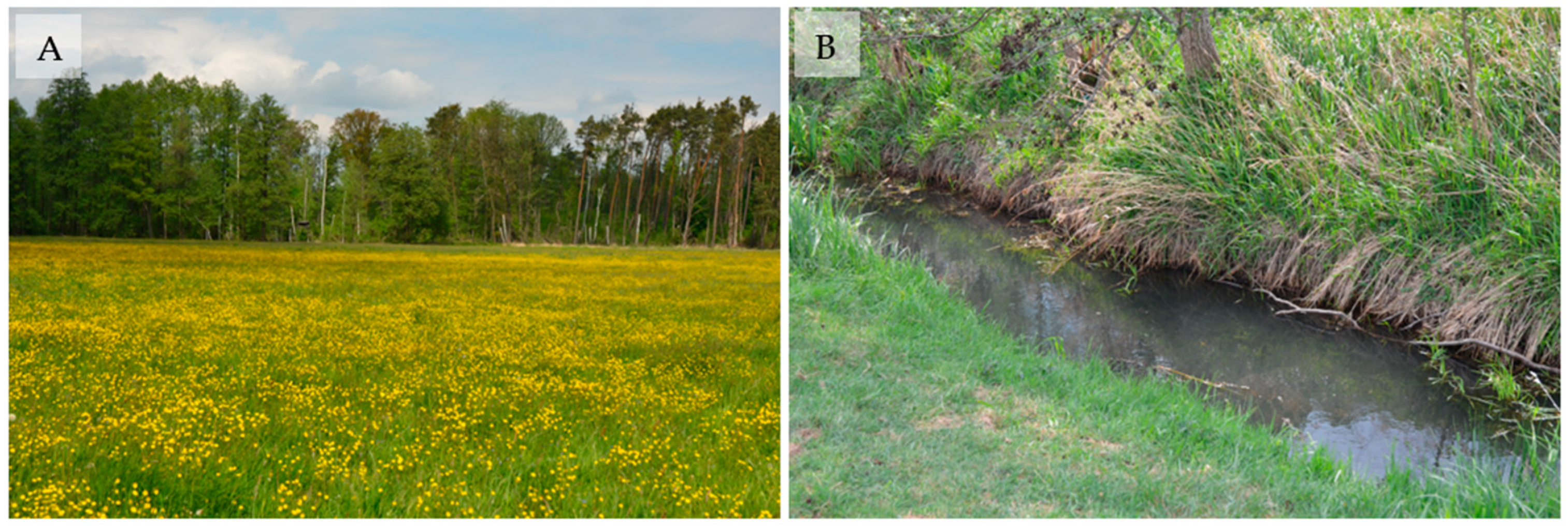
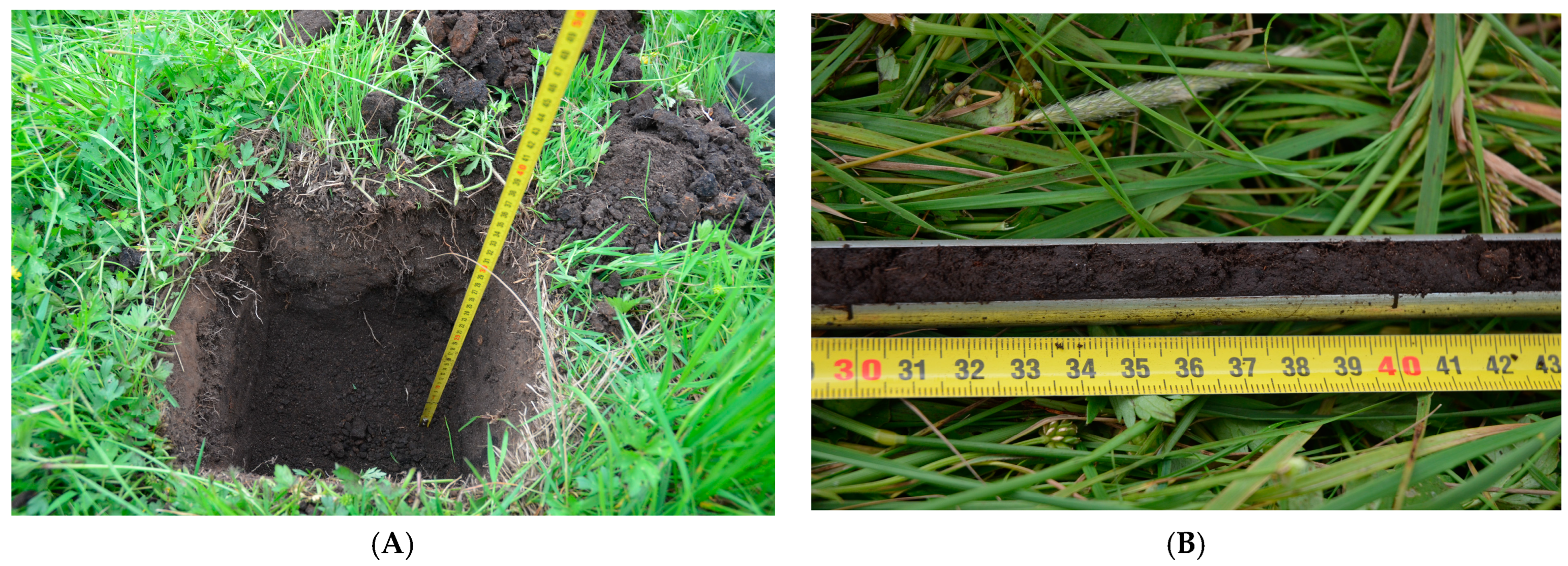
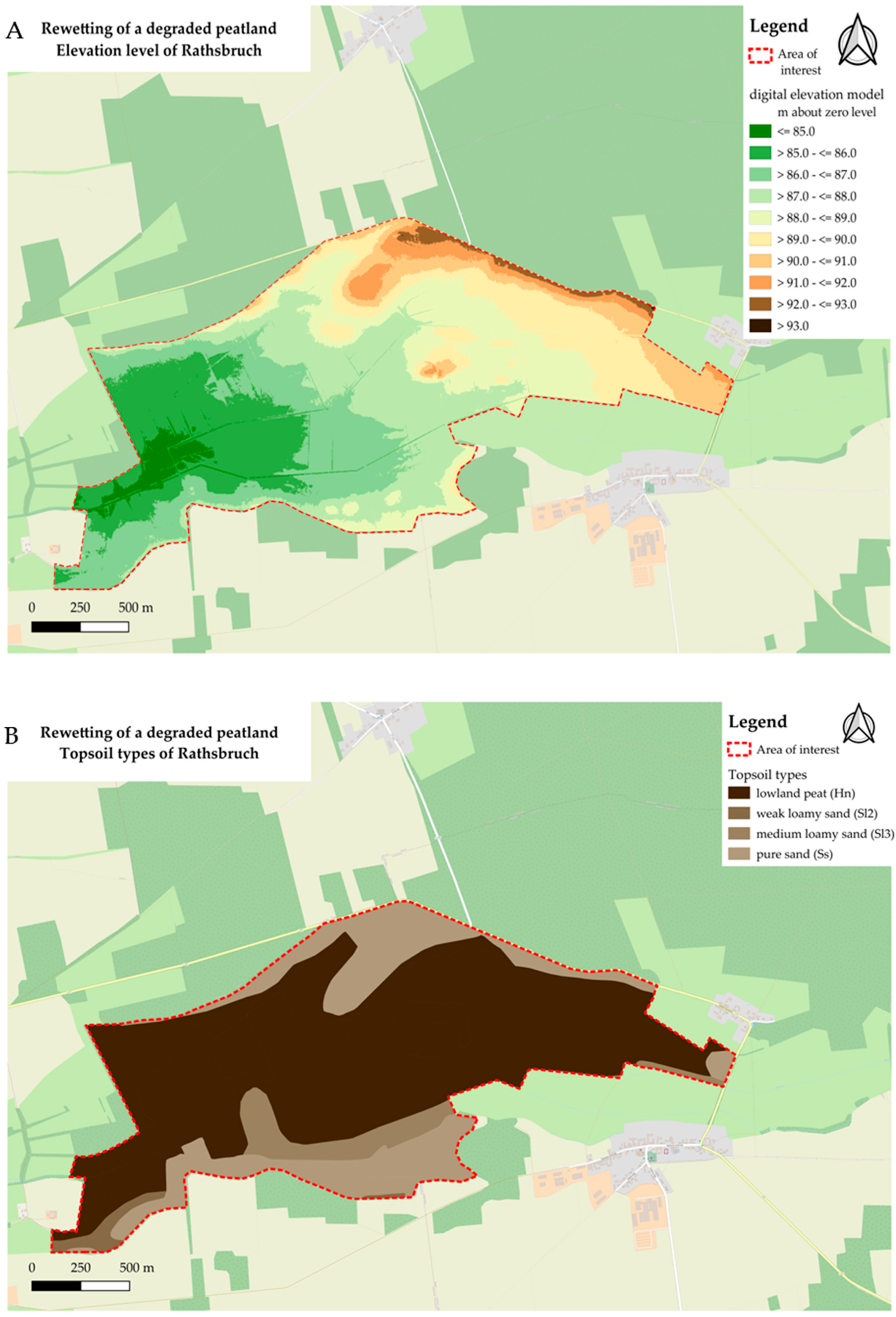
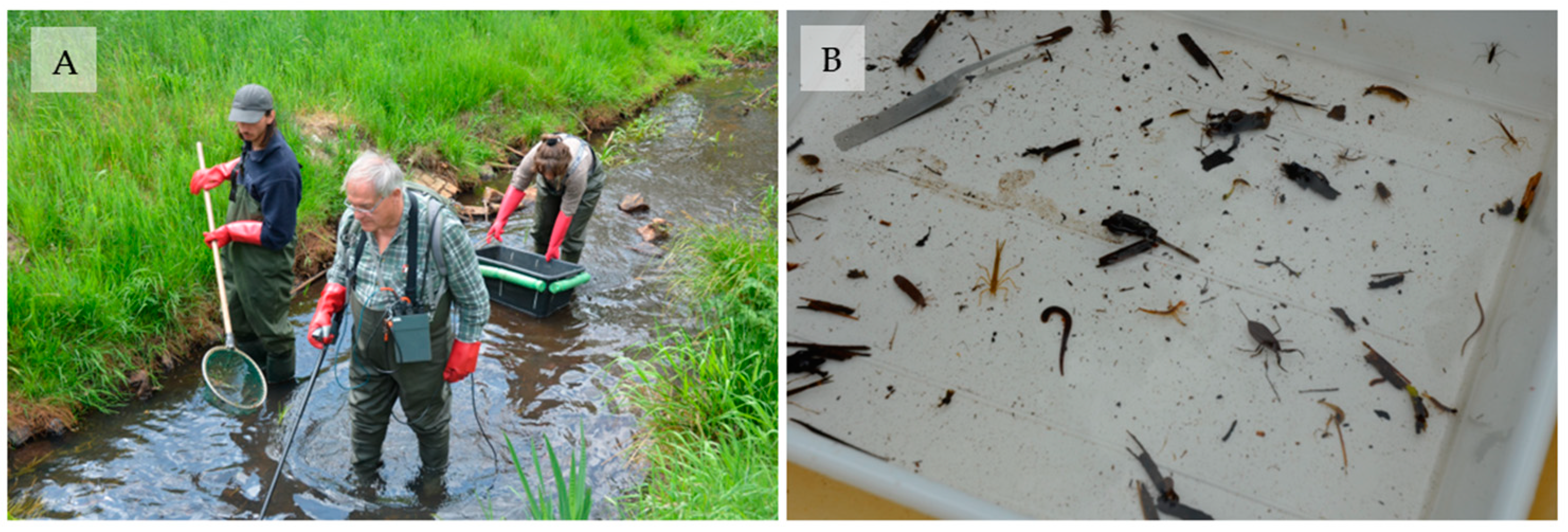
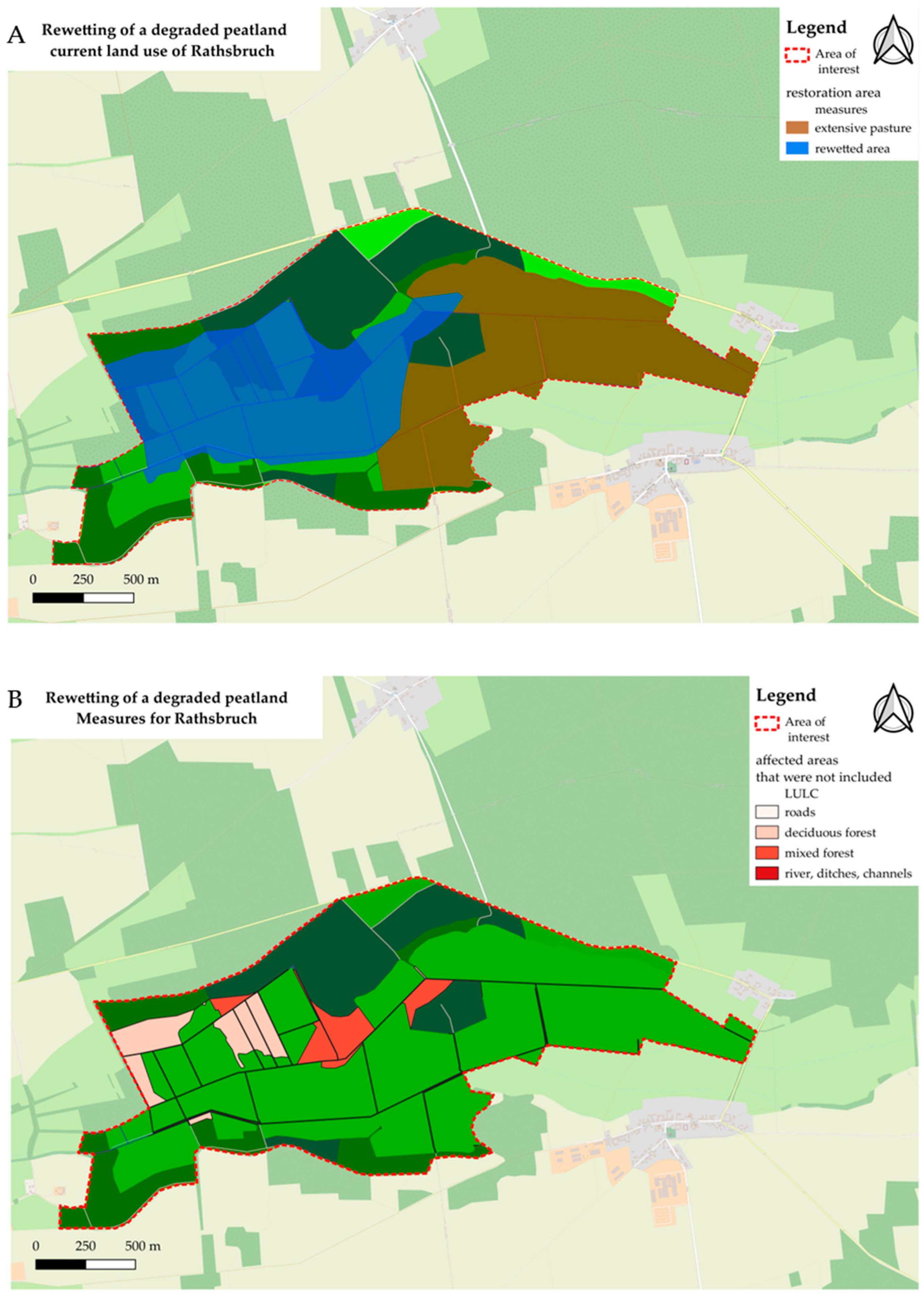

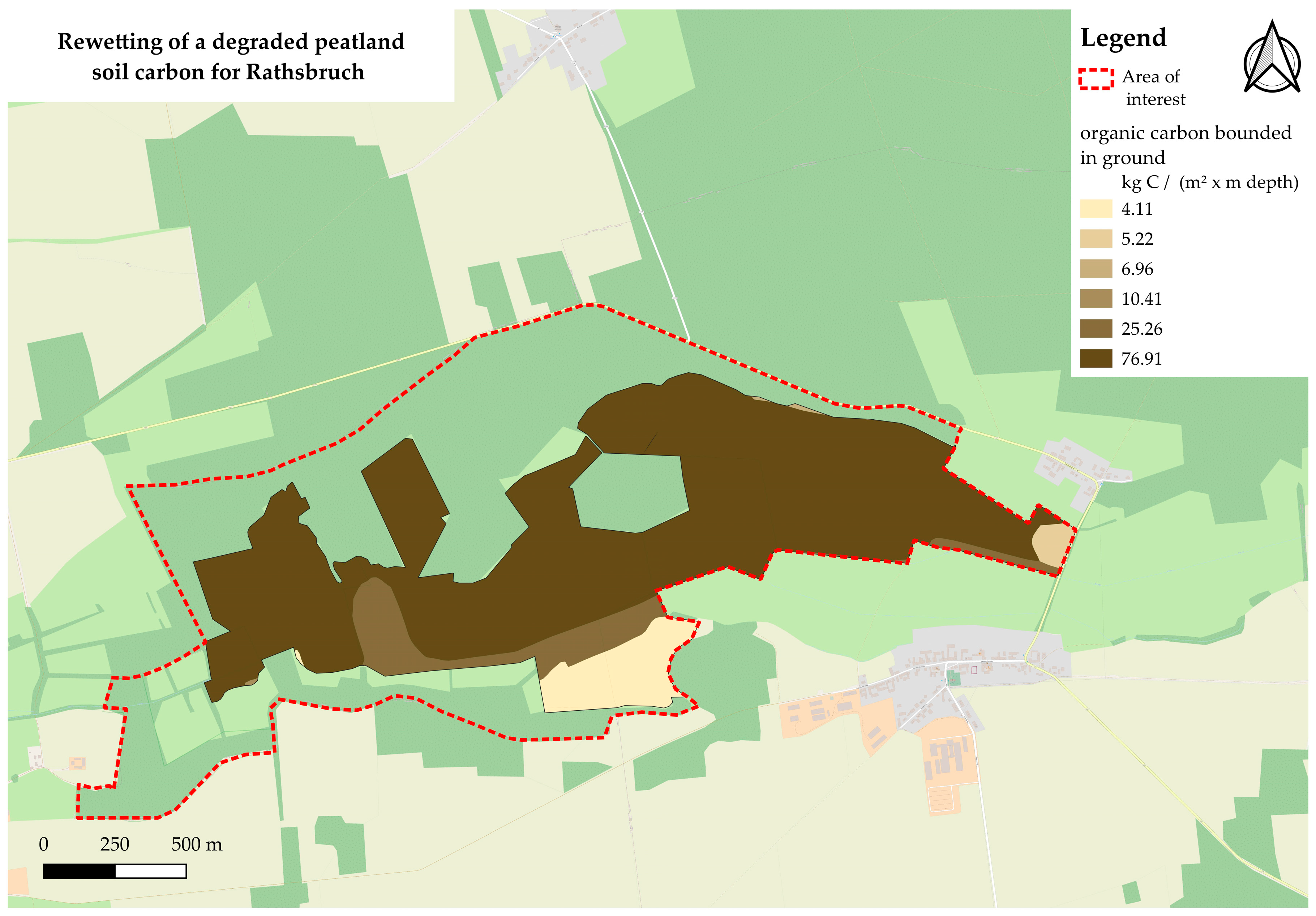
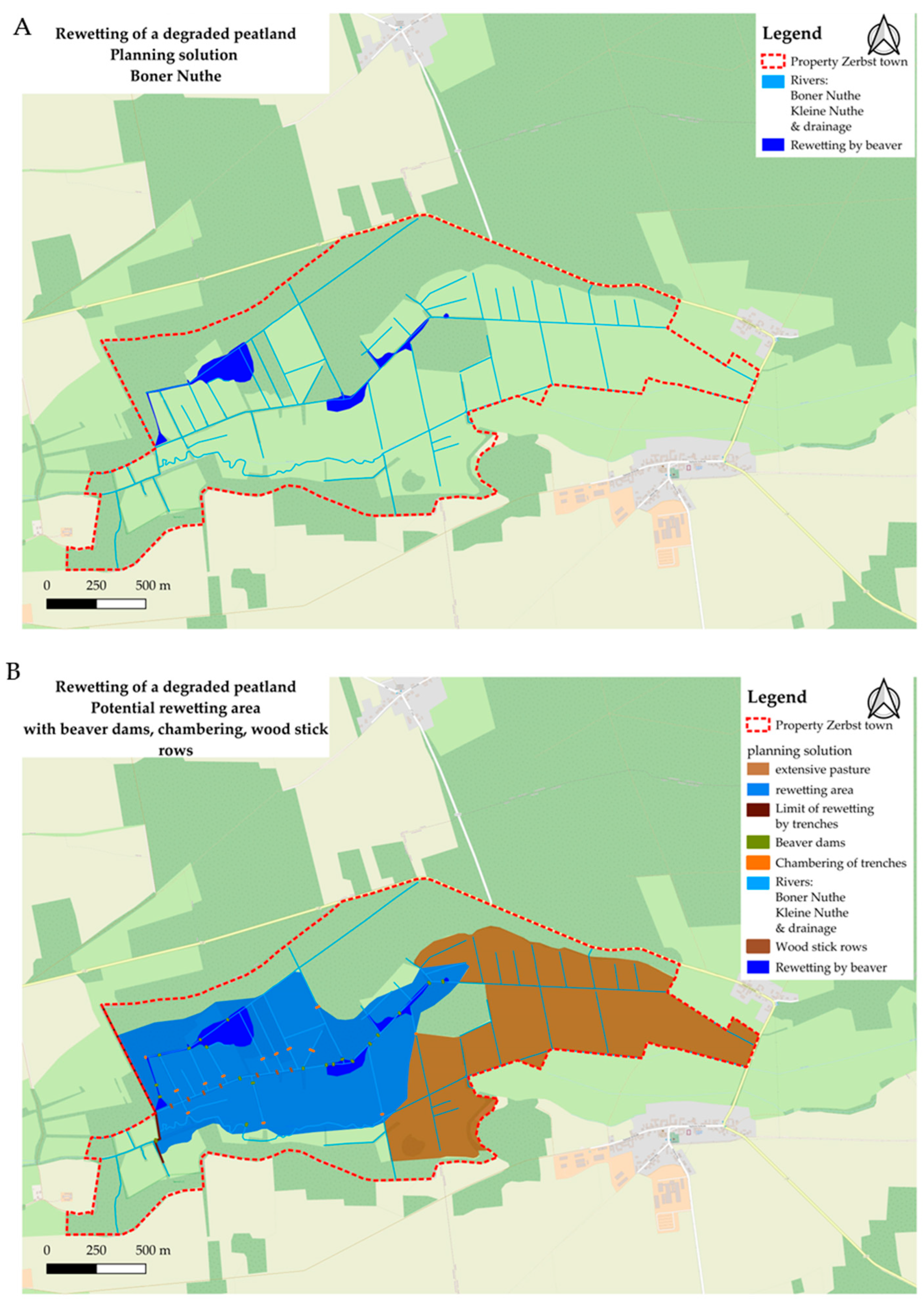
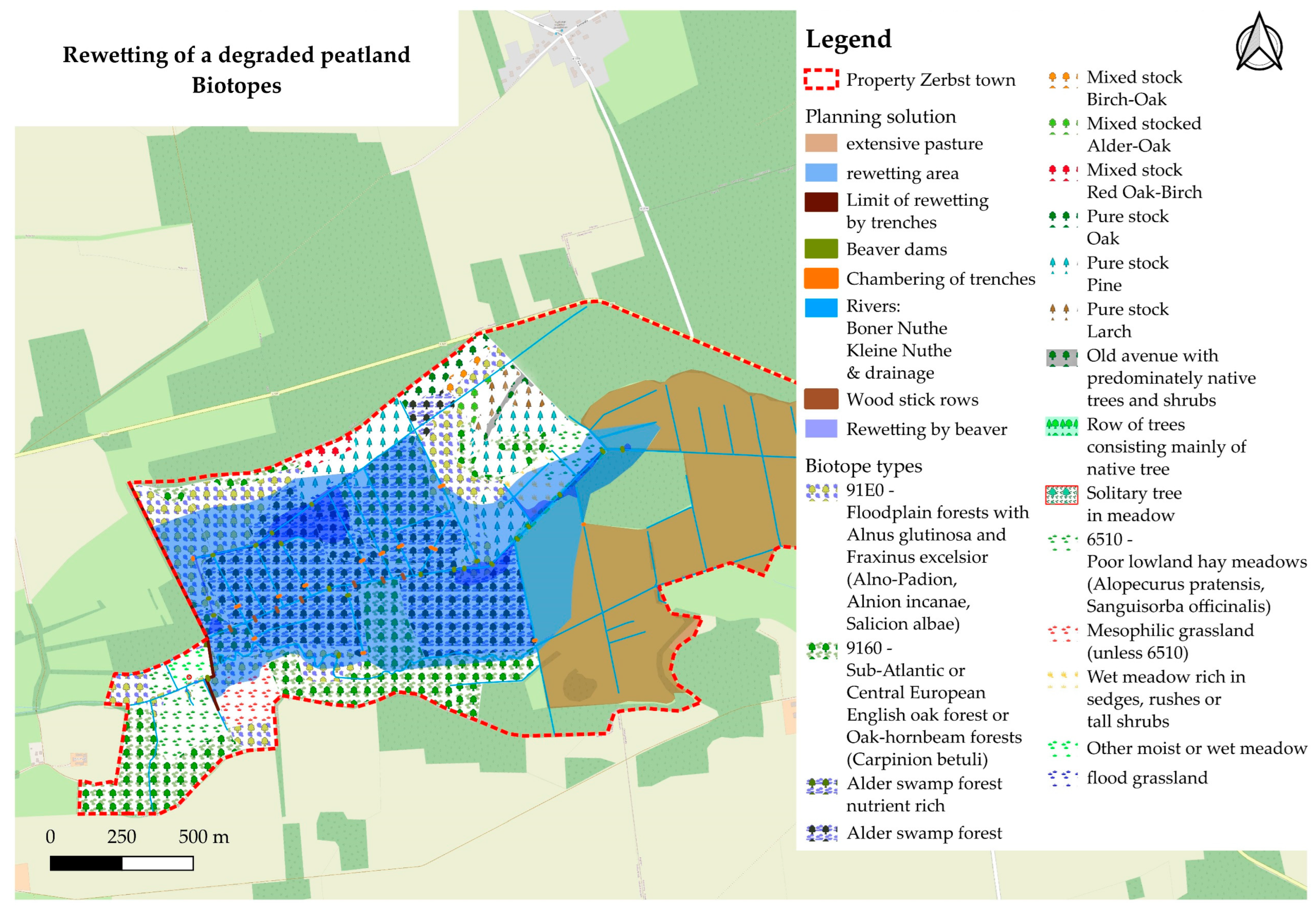
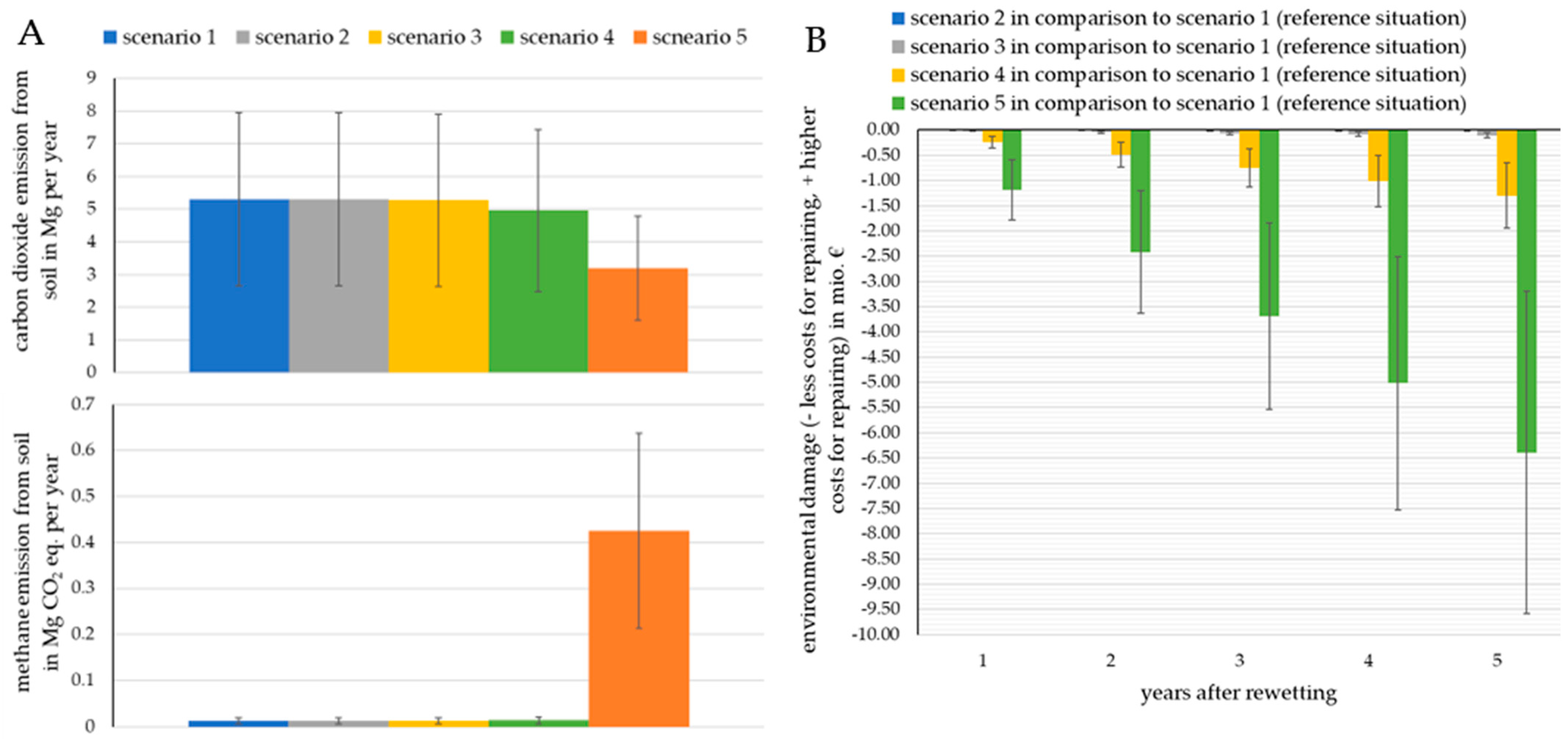
| LULC | Area [ha] |
|---|---|
| Cropland (non-irrigation) | 0.18 |
| Dirt roads | 2.22 |
| Paved Roads | 0.04 |
| Deciduous forest | 46.96 |
| Mixed forest | 57.77 |
| Coniferous forest | 9.98 |
| Channels, ditches, and river | 3.31 |
| Pasture and meadow | 174.74 |
| Scenario | “Pasture and Meadow” [m] | “Rewetting” [m] |
|---|---|---|
| 1 | −1.0 | −1.0 |
| 2 | −1.0 | −0.8 |
| 3 | −1.0 | −0.5 |
| 4 | −1.0 | −0.3 |
| 5 | −1.0 | −0.1 |
| Sector 1: Rewetting Area | Sector 2: Downstream | |
|---|---|---|
| Water body type | 11 | 14 |
| MI species number | 26 | 53 |
| Saprobic Index | moderate | good |
| General degradation | bad | good |
| Ecological status class | bad | good |
| Quality Characteristic and Parameter | Score |
|---|---|
| (1) Inventory of species and guilds | 2 |
| (2) Species abundances and guild distribution | 1.53 |
| (3) Age structure (reproduction) | 1.0 |
| (4) Migration | 1.0 |
| (5) Fish region | 1.0 |
| (6) Dominant species | 2.0 |
| Overall evaluation | 1.43 |
| Ecological status class | bad |
Disclaimer/Publisher’s Note: The statements, opinions and data contained in all publications are solely those of the individual author(s) and contributor(s) and not of MDPI and/or the editor(s). MDPI and/or the editor(s) disclaim responsibility for any injury to people or property resulting from any ideas, methods, instructions or products referred to in the content. |
© 2024 by the authors. Licensee MDPI, Basel, Switzerland. This article is an open access article distributed under the terms and conditions of the Creative Commons Attribution (CC BY) license (https://creativecommons.org/licenses/by/4.0/).
Share and Cite
Schneider, P.; Fauk, T.; Mihai, F.-C.; Junker, H.; Ettmer, B.; Lüderitz, V. Natural Climate Protection through Peatland Rewetting: A Future for the Rathsbruch Peatland in Germany. Land 2024, 13, 581. https://doi.org/10.3390/land13050581
Schneider P, Fauk T, Mihai F-C, Junker H, Ettmer B, Lüderitz V. Natural Climate Protection through Peatland Rewetting: A Future for the Rathsbruch Peatland in Germany. Land. 2024; 13(5):581. https://doi.org/10.3390/land13050581
Chicago/Turabian StyleSchneider, Petra, Tino Fauk, Florin-Constantin Mihai, Harald Junker, Bernd Ettmer, and Volker Lüderitz. 2024. "Natural Climate Protection through Peatland Rewetting: A Future for the Rathsbruch Peatland in Germany" Land 13, no. 5: 581. https://doi.org/10.3390/land13050581
APA StyleSchneider, P., Fauk, T., Mihai, F.-C., Junker, H., Ettmer, B., & Lüderitz, V. (2024). Natural Climate Protection through Peatland Rewetting: A Future for the Rathsbruch Peatland in Germany. Land, 13(5), 581. https://doi.org/10.3390/land13050581












